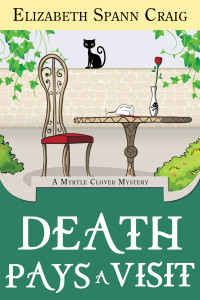By Elizabeth S. Craig, @elizabethscraig
I think by now most of us have agreed that, whether they should or not, covers have a tremendous impact on what readers purchase.
In a split second, a good cover indicates a book’s genre. This is probably the most important role of a cover, in commercial fiction.
As Mark Coker of Smashwords states in his free ebook, The Secrets to Ebook Publishing Success:
Your cover is the first impression you make on a prospective reader. It’s the visual embodiment of everything your book represents. Great covers, through their imagery alone, can communicate genre, topic, mood and setting. A great cover image makes a promise to prospective readers. It helps them recognize your book as one they’ll enjoy reading.
I actually received an email from a reader recently. She’s an avid reader of the Myrtle books and also enjoys the Southern Quilting mysteries. She hadn’t, oddly to me, ever commented on my Memphis Barbeque books (and I knew that she was aware that I write that series under a pseudonym). She told me in her email that the Memphis books looked very “serious” and she’s a fan of humorous mysteries. She decided to give them a go recently and told me “I guess you can’t judge a book by its cover” since she’d enjoyed the books and found them the humorous/bordering-on-campy reads that I usually create.
In her email, she particularly referenced this Memphis cover as one that had given her pause:

I had a conversation in the comments with writer Meg Wolfe last week about tone in our books. I mentioned that the title above, Hickory Smoked Homicide, had had a darker tone to it—because I was in a dark mood, for some reason. I had nothing going on in my life to justify the dark mood, except the fact that this book was incredibly difficult for me to write and I think the struggle, weirdly, came out in the tone. This was the book that I nearly deleted several weeks before deadline out of complete frustration. Then I had an epiphany after speaking with a friend who had grown up in the culture I was writing about, and the book ended up working out really well.
But! The cover designer at Penguin totally picked up on the tone and you can see it in the cover. It did scare away some cozy readers of mine, I’m sure. But I ended up receiving more emails from male readers than I ever had. So maybe it ended up working out for me in the end.
I definitely have a particular feel in mind when I’m contracting a cover for my self-published books. This is a cover that I got back on Wednesday from my current cover designer, Karri Klawiter for a book that will come out this fall (yes, I’ve found it smart now to go ahead and get covers for books that I haven’t even finished writing yet):

To me, this is the kind of cover that clearly indicates a light mystery.
We know it’s important, but how do we connect with a good cover designer if we’re self-published authors? Well…it does take a little research. Most authors are great about sharing on their blogs who did their covers—considered a nice plug for the designer they worked with. So, if you browse your genre on Amazon, paying special attention to the lower-priced books (because, the way the current climate is, those are still more-likely to be self-published books), make note of the book titles that reflect the cover look you’re going for. Then you can click on the author’s Amazon Author Central page, which ordinarily connects to a blog. Then you can search the blog for keywords like “cover designer.”
I also maintain a free spreadsheet of ebook professionals, which include cover designers.
So, these are my observations from a non-designer side of the business. What observations have you made about your own covers and what works?
Hickory Smoked Barbeque has a great cover.
Covers are important. If a cover doesn’t grab me, I’ll never even bother with the synopsis. I’m drawn to a artistic covers. (Not a surprise I read science fiction and fantasy, is it?) Title and one color just won’t do it for me.
Always been happy with the covers my publisher did for my books though.
Alex–I like your covers, too.
And thanks–it *is* a great cover. Was it a *cozy* cover? Well…maybe not, ha! But the artist is extremely talented.
Elizabeth – Covers really do have an impact, don’t they? And I think it’s fascinating that your struggles with Hickory Smoked Homicide came through in some way to the cover designer. It’s fascinating how those vibes can work. I also think it helps if all of the books in a series have a ‘series brand’ on the cover. For instance, Lilian Jackson Braun’s Cat Who… books each had those ‘pawprints’ on the cover. Readers know instantly which series they’re buying that way, even if they read more than one series by the same author.
Margot–That *does* help and it’s been something I’ve been a little slow to do with my self-published series since I don’t have a design background myself. But the quilting mysteries always has a corgi on the front. The Memphis Series has a pig around the word “BBQ” at the top (hard to see in the cover on this page, but it’s at the very top). My Myrtle series does have very specific design elements regarding the series title, though, although those were replicated to appear similar to the original, trad-published book. So…yeah. Branding is a good thing! Braun was smart to do those paw prints.
No one has ever made a comment on my covers. Oh; except one graphic designer who trashed every choice I made about the cover for The Commonsense Virtual Assistant which turns out to be my best-selling non-fiction book.
As you say, a cover has to do more than sell the book, it must make a promise the book keeps. If the cover says “vegan” but the book is barbecue, you may make the sale but you won’t earn a fan.
Joel–Ah, well, you know designers. I’ve worked with different ones and I think most of them have found design issues with the covers that I’ve had done by the other designers. :) I think your covers look great (but what do I know? Ha!)
Good word there–yes, it makes a *promise* to the reader. The “Hickory Smoked Homicide” cover (evocative, I think, of “Fried Green Tomatoes at the Whistle Stop Cafe”) doesn’t necessarily promise humor, although it definitely promises something for the carnivorous reader! I did have a lot of humor in that book, although, admittedly, it was pretty dark and reflective of my bad mood at the time. I think I need to chill out when I’m writing more…
As a reader I know I miss out on a lot of wonderful books out there because unfortunately the book cover didn’t catch my eye when I am busily selecting books. I’ve read books that were extremely good and thought that they would have a far greater audience if their cover was different. The Hickory Smoked Homicide cover was a bit different than your usual covers, but still very appealing for a mystery. For cozy mysteries I normally look at covers that are cheerful and bright (funny I know) and for thrillers I look for more serious, dark covers.
Mason–Mystery covers seem especially important, don’t they? So many subgenres of the genre. And thrillers are so different from cozies!
Elizabeth, excellent points about covers. I’m going through the cover design process right now for my next indie title, and “mood” and “theme” are on my mind. Same with “keeping a promise”. I’m definitely drawn to books with excellent covers. However, some of my favorite reads by favorite authors had funky covers. If I didn’t already love the author and respect their work, I wonder if I would’ve picked up the book?
Julie–I wonder the same thing…if I didn’t know the genre/author, there are several books I would have passed up.
I love covers. Most of them are such a perfect representation of what I’ll be getting when I pick up that book. Then again, there’s nothing worse than a cover that promises one thing on a book that delivers something else completely… I haven’t even finished a book, but I still fantasise about the covers my stories may have one day…
Tessa–Good luck with your book! I love covers, too…and, as a writer, I love them as the marketing tool they are.
You know, your point about drawing in the male readers brings up the same thought as one or two of your other recent posts: if you have enough books in the series (and better yet, several series) you have multiple chances at catching readers.
So the reader who didn’t like serious books didn’t start the Memphis BBQ series right away… she’s reading them now!
I’ve had this happen to me so many times as a reader — where I avoid certain books by a favorite author until I finally try them and love them — that I don’t even think of it as “avoiding” any more, but rather as “saving for later.”
I do think, however, that it is important to have the right cover, and in particular to have an _identifiable_ cover — branded cover — for a series. I’m an artist, so maybe I’m biased, but I always find it fun to see what variation on the brand the next book will have.
Camille–Right–with a few series and plenty of books in each one, we do have opportunities to snag different types of readers…if we try to.
I’ve done the same thing, come to think of it, that you and my reader did–avoided Barbara Vine books because I thought they’d be too different from the Ruth Rendell books. Now the books are interchangeable to me.
Branded series covers…yes. You’re good at that and since you can do your own covers, yours all have a particular style that carries over…a nice touch. I’ve always wanted to be able to draw. I would *never* do a cover of mine. I have trouble even formatting a cover page. :)
I am surprised to find that for me, the cover has been the hardest part of creating a book. I have viewed hundreds of samples covers and templates and haven’t been able to decide on a designer. Granted, I’ve had a very busy month, but I know I have been avoiding the decision. I’ve managed to put down 15k into my next book to avoid working on the cover.
How will a designer be able to come up with the right cover for my book? What if I don’t like it? What if their design ideas don’t convey the right feel? I know I have to just make a decision and go with it, but I didn’t expect I would find this part so hard.
I’m assuming it gets easier with subsequent books (I hope).
Silas
I mean 15k words, not 15k $$$. If I had $15k to put into a book, I’d get a few designers and not worry about it.
Hi Elizabeth – if it had been me – I’d have been interested to see a darker side of cozy mysteries … but then I like change. Interesting how your mood came out in your story though and the designer picked that up …
Some covers completely turn me off .. but I’m usually looking for something serious to read and now-a-days I’m not into reading much fiction …
Interesting post to read – especially with the comments … there’s such a lot to consider … but great you’re around to help us … cheers Hilary
Hi Elizabeth
This is the one thing I’ve really struggled with recently. We use a terrific designer, but he can take ages to get anything done!
With one of my series, we were never quite happy with the cover we had. It looks great but didn’t really capture the book for me. We’ve recently linked up with an artist and had new covers drawn which I’m really excited about. The cover designer, upon receiving the art work, was very upfront in telling me he doesn’t think the books will sell!
As you can imagine, that left me feeling somewhat down. However, to his credit, he worked hard on changing the fonts etc to suit the new image and we’re now really thrilled with it. AND it suits the book. Whether it will sell or not is of course something we’ll only find out in time.
The irony is that for my first series, the cover came together very quickly and we knew immediately it was right thing. You can never tell.
The one comment I’d make regarding advice is to spend as long as you need getting a clear picture in your head of what you want your cover to look like. Spend time exploring what other writers in your genre do and figure out what you like and don’t like. If you don’t have an image in your head of what you’d like it to be, try to decide what you want people who look at your book to feel, other than ‘ooh, i must buy that’ :) Telling the designer the reaction you want the cover to create in others can be very useful.
cheers
Mike
Michael–I’m sorry about that feedback you got from the designer! Hoping that he’s wrong. If he’s *right*, the nice thing is that you can always change the cover later. And you’re so right–you can never tell.
I think your advice is very, very good. While I struggle at both Penguin and with my self-pub designers with giving them direction for the cover (my sense of design is practically non-existant), I’m much, much better at attaching images of covers that I do like and don’t like. I think that helps the designer out a ton.
I got a recommendation for a cover artist from another author. I’ve been really pleased. I give her some suggestions then let her do her job. She usually has way better ideas than I do. And I always tell her the genre and audience so she can get the ‘feel’ right. Finding a good artist is important. Although, I think it’s more important they understand how to sell books via art/covers.
Mary–That’s another great way to find an artist–through recommendations. You’re right–the best cover designers have a strong market sense.